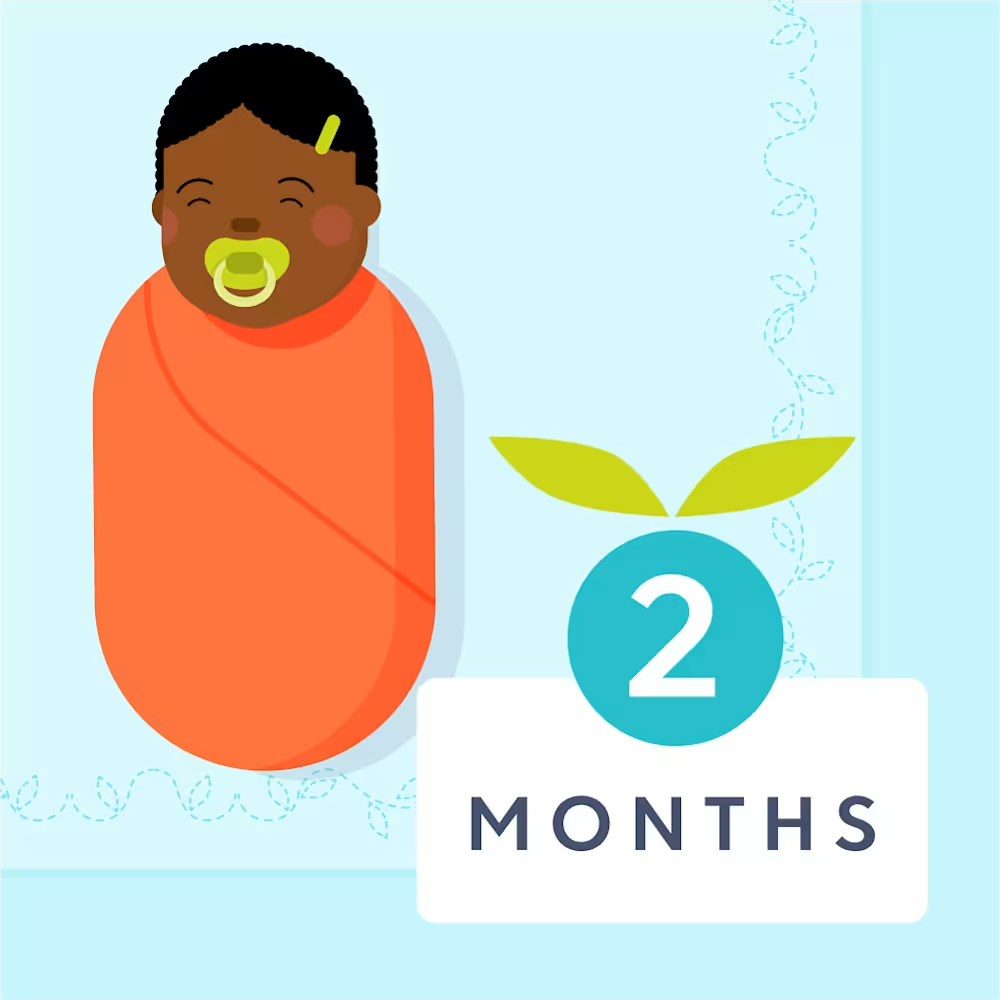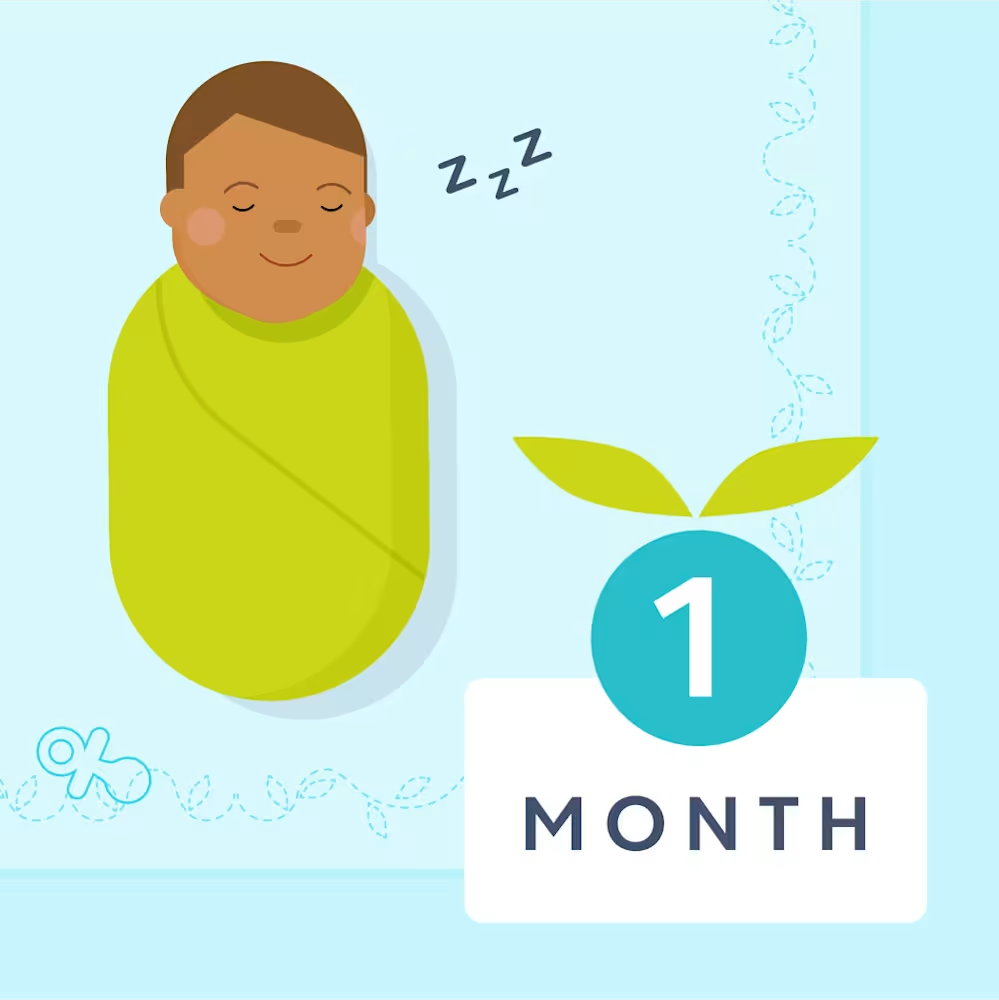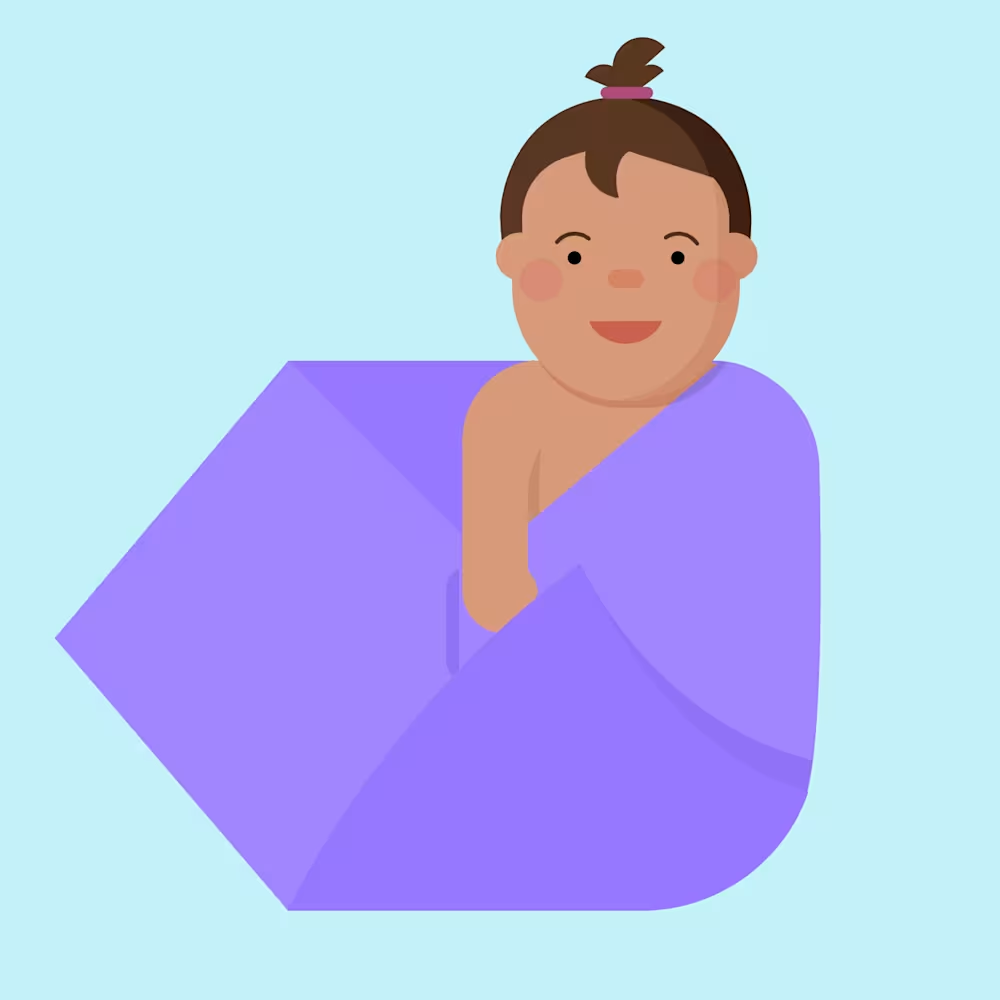3 week old sleep schedule: Bedtime and nap schedule
Updated Dec 15, 2025
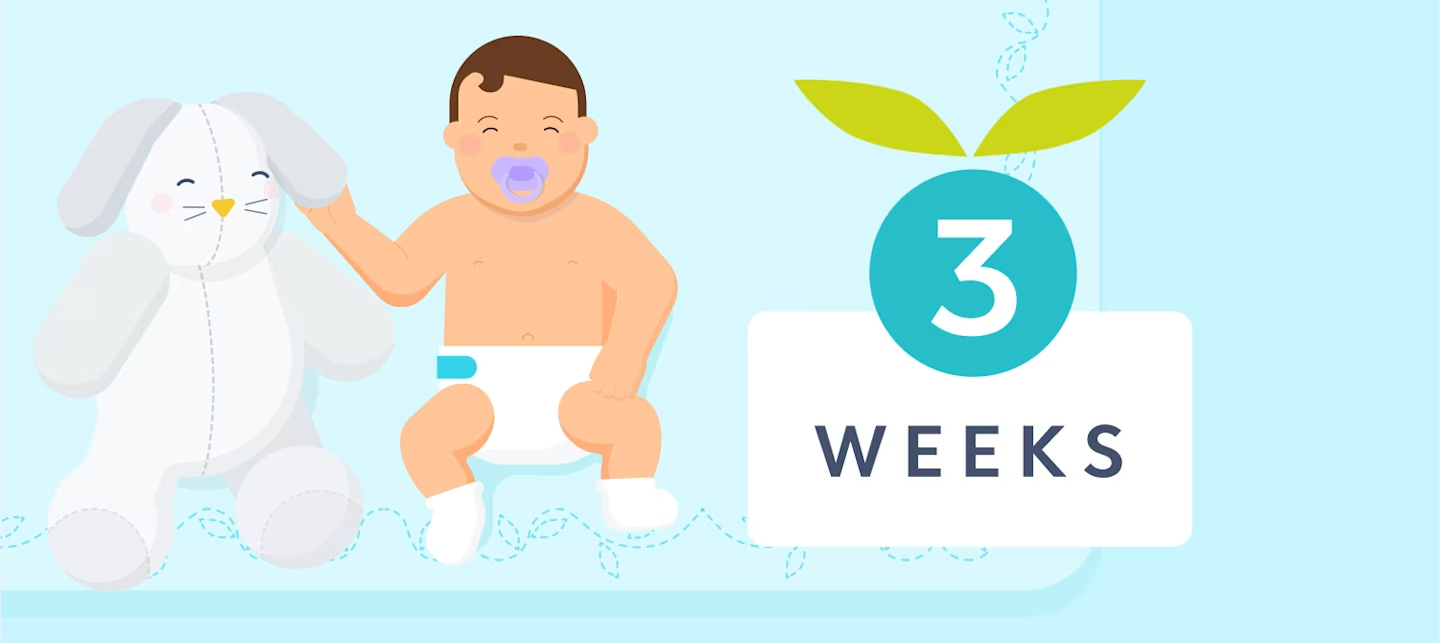
By now you’ve surely noticed that newborn sleep is pretty chaotic. Your 3 week old may take a 20-minute nap, stay awake for an hour, then snooze for two hours during their next sleep period! This is normal for babies in their first few months of life. Sleep schedules don’t typically become more predictable until closer to 3 - 4 months old.
That said, in this article, we’ll walk you through what to expect (or not to expect) when it comes to sleep at 3 weeks and reassure you that your newborn’s sleep patterns are typical for this age group.
Editor's note
The recommendations listed in this article represent the average amount of sleep typically needed at this age. However, please note there is a wide range of normal as some children have lower or higher sleep needs. Also note for children who were born early, we go by their adjusted age for sleep development.
Table of Contents
How much should a 3 week old sleep?
It’s hard work being a new baby! According to the American Academy of Pediatrics, newborns usually sleep for about 16 - 17 hours per day []. However, they may only sleep 30 minutes - 2 hours at a time, even overnight as they wake for feeds and comfort. This is normal! While sleep may feel chaotic, rest assured that you can be doing everything “right” and babies still won’t have a typical 24-hour cycle for sleeping and eating until closer to .
Babies can typically comfortably stay awake for around 30 - 90 minutes in these first few weeks, so you’ll likely feel like all you have time for is changing your baby’s diaper, feeding them, and then they’re ready to snooze again.
Also, note that there’s a wide range of normal when it comes to babies and sleep. Don’t fret about hitting a specific number of hours or naps, especially in these first few weeks and months. These recommendations are just estimates. It’s important to gauge your baby’s overall mood and energy levels when evaluating whether or not they’re getting enough sleep every day.
Here's a quick overview of what you may expect when it comes to 3 week olds and sleep. Note that these figures are averages and should be used as guidelines.
| Sleep guidelines | Average/range |
|---|---|
| Average total sleep | 16 - 17 hours |
| Number of naps | Varies |
| Goal daytime sleep | Varies |
| Wake windows | 30 - 90 mins |
Sample schedule for 3 week olds
At 3 weeks, your little one's "schedule" will likely still be unpredictable. Sleep times and durations will vary and this is normal! Here's what a day in the life of a 3 week old newborn may look like:
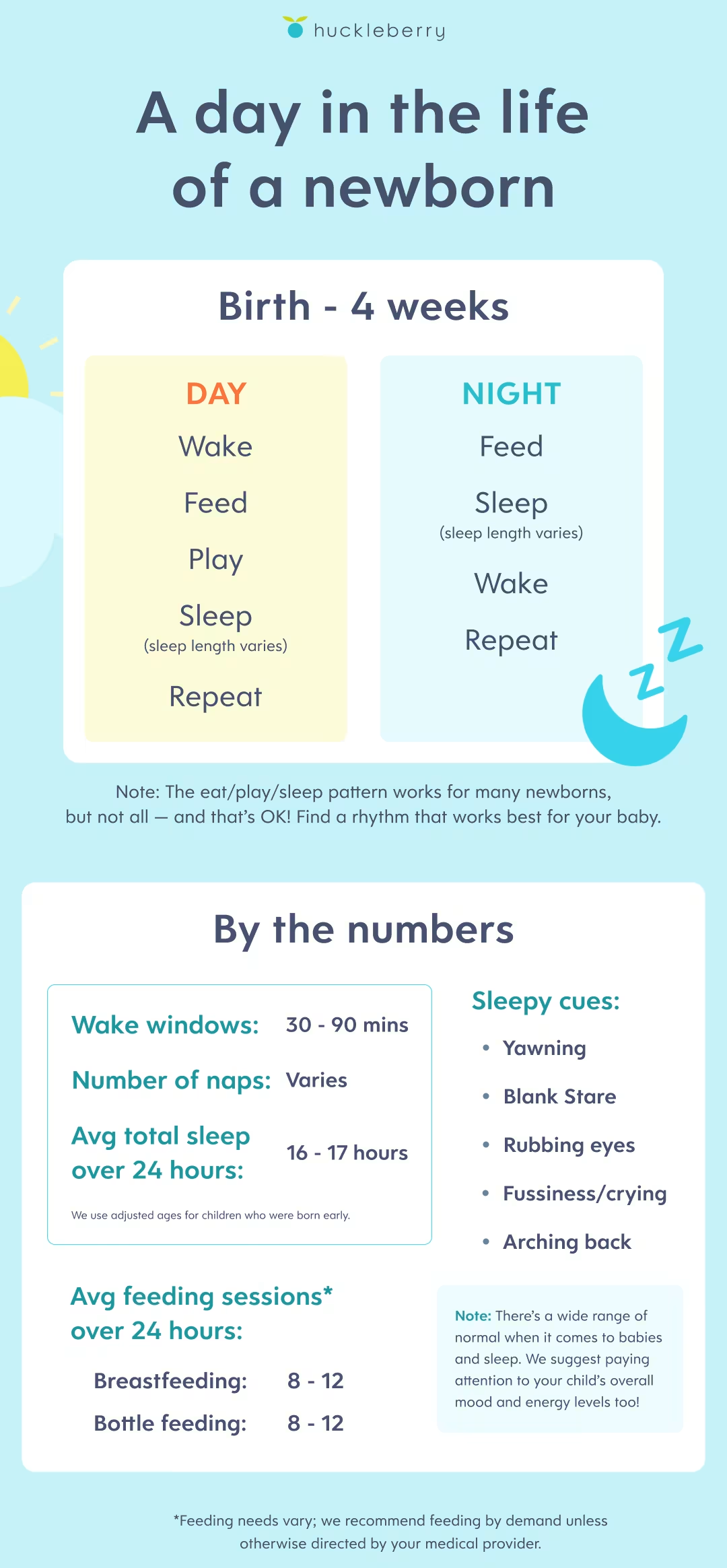
Top sleep tips for 3 week old
Due to an immature circadian sleep-wake system, most babies this age have sleep that’s pretty evenly distributed between day and night. However, it’s not uncommon for newborns to confuse night and day [] in their first few weeks of life, which can result in babies wanting to sleep all day and party all night.
Day/night confusion typically resolves at around . To help “fix” their day/night reversal a bit faster, try to keep your little one’s environment bright and noisy during the day and quiet and dark at night. It can also be helpful to do your best to avoid stimulating [] or waking your child when you feed or change them overnight.
Editor's note
While you may be eager to settle into a routine with your baby and work on sleep habits and a “schedule,” we won’t expect much regularity with their sleep until after they reach 3 - 4 months old. Timing and sleep durations can greatly vary in the beginning. However, consider taking advantage of their sleepiness and flexibility at this age. Newborns are typically pretty good at falling asleep when you’re out and about. Run that daytime errand [2], even if your little one doesn’t make it all the way home before falling asleep. However, be sure to move your baby to a firm surface on their back as soon as possible, in accordance with the American Academy of Pediatrics’ [3] safe sleep recommendations.
Naptime schedule for 3 weeks
How long should a 3 week old nap?
There’s not a magic number when it comes to 3 week old nap habits. Expect your baby’s nap lengths since babies aren’t born with predictable or organized sleep cycles []. This means your little one could nap for 30 minutes or two hours and both would be considered “normal” at 3 weeks.
Instead, try focusing on and when determining when your baby may be ready for sleep again. At 3 weeks, babies can usually stay awake for around 30 - 90 minutes before it’s time for sleep. If they’re rubbing their eyes, staring off into space, yawning, or becoming fussy, these may be sleepy cues that your baby is showing to indicate they’re ready for bed. Since these signs can be fleeting and easy to miss, we recommend aiming for a nap if they’ve been awake for over 1.25 hours and haven’t shown sleepy signs.
How many naps for a 3 week old?
We don’t recommend trying to follow a specific sleep schedule or number of naps at 3 weeks old. Babies don’t have an organized circadian rhythm [] in the first months of life, which means sleep will likely be without a pattern at this time. Instead, sleep is controlled by sleep pressure and hunger at 3 weeks. You’ll probably see short and long periods of sleep and plenty of wakings for food and snuggles over a 24-hour period. This is normal!
Bedtime for 3 week olds
What time should a 3 week old go to bed?
Bedtime may be on the late side at this age since their schedule is still so irregular. Don’t be surprised if their longest stretch of sleep in a 24-hour period starts at 10:00 PM — or even later. This won’t last forever, though. Most babies will be ready for an earlier bedtime at around .
You may be tempted to keep your baby up longer during the day in hopes of an earlier bedtime and longer stretches of overnight sleep, however, this can often lead to . Being too tired makes it harder for a newborn baby to fall asleep and stay asleep versus a little one who’s had adequate daytime sleep.
Why does my 3 week old keep waking up at night crying?
It’s completely normal for a 3 week old to wake multiple times during the night. At this stage, frequent waking is expected as babies need to eat often and seek comfort. Most infants are not yet physically capable of sleeping through the night until .
Is there a sleep regression at 3 weeks old?
Sleep patterns can change at any time, but major typically occur around 4 months, 8 - 10 months, 12 months, 18 months, and 2 years, coinciding with big developmental shifts. If your 3 week old’s sleep suddenly changes, it’s likely due to , cluster feeding, or adjusting to life outside the womb rather than a "sleep regression." It’s completely normal for babies at this age to wake frequently throughout the day and night. By 3 to 4 months, many little ones start to develop a more structured sleep and feeding rhythm.
Can my 3 week old sleep with a pacifier?
Pacifiers can be introduced from birth, though if you’re breastfeeding, some experts suggest waiting a few weeks to ensure that feeding is well-established. The American Academy of Pediatrics (AAP) recommends introducing a pacifier once nursing is going smoothly, typically around 3 to 4 weeks []. However, there is little evidence to confirm that early pacifier use leads to “nipple confusion” [].
Pacifiers can provide several benefits, including soothing your baby and potentially reducing the risk of sudden infant death syndrome (SIDS) []. They are also often recommended for preterm or low-birth-weight babies to support their sucking reflex.
Should I swaddle my 3 week old?
Swaddling can help newborns feel secure and promote better sleep by preventing sudden movements caused by the Moro reflex from waking them up []. Since newborns are easily startled, swaddling can create a comforting, womb-like environment that encourages longer sleep stretches.
According to AAP safe sleep recommendations, always place your baby on their back for sleep, whether they are swaddled or not []. It’s also important to use a “hip-healthy” swaddling method, allowing their legs to move freely to prevent hip dysplasia. As soon as your baby starts showing signs of rolling over, which can happen as early as 2 months, it’s time to stop swaddling.
Can I sleep train my 3 week old?
is not recommended for newborns. At 3 weeks old, babies are still learning to regulate their sleep, and they depend on external comfort to help them fall and stay asleep. It’s completely normal for infants at this stage to need assistance with sleep. However, if your baby struggles to sleep and you’re looking for gentle approaches, we can provide age-appropriate strategies to help establish healthy sleep habits early on.
Can a 3 week old sleep on their stomach or side?
Unless specifically advised by a healthcare provider, a 3 week old should always sleep on their back. The AAP’s safe sleep guidelines recommend placing newborns on a firm, flat surface for all sleep, including naps []. Once your baby has developed the ability to roll independently in both directions (back to front and front to back), you won’t need to reposition them if they roll over during sleep.
What are the developmental milestones for a 3 week old?
At 3 weeks old, your baby is still focused on eating and sleeping, and they haven’t yet developed motor skills like rolling over or sitting up. However, they are rapidly learning about their surroundings through sight, sound, and touch while strengthening their bond with caregivers.
By the end of , here are some developmental milestones you might notice:
Regains birth weight and begins gaining consistently
Brings hands close to the face and mouth
Keeps fists mostly clenched
Shows natural newborn reflexes, including rooting, sucking, Moro (startle), grasping, and stepping reflexes
Does a 3 week old need to eat at night?
for feeding and comfort is entirely expected at this age. A 3 week old baby still has a small stomach, meaning they will wake regularly to eat, both during the day and overnight, to meet their nutritional needs. If your baby is in their sleep space from around 10:00 PM to 7:00 AM, they will likely need at least 2 - 3 night feedings.
As your baby grows and their stomach capacity increases, they may naturally start sleeping for longer stretches between feeds. However, most babies do not fully night wean until closer to 6 months old [].
Takeaway
Newborn sleep is unpredictable! Since babies aren’t born with established sleep-wake patterns, they don’t typically follow a structured sleep schedule or have consistent sleep durations. Around 3 to 4 months of age, most babies start developing more predictable 24-hour rhythms for sleeping and feeding.
To help determine when your newborn is ready to sleep, look for sleepy cues and use wake windows as a general guide. Rather than only tracking the number of hours they sleep, also pay attention to your baby’s mood and energy levels to gauge whether they’re well-rested.
It’s completely natural for newborns to wake frequently at night for feedings and comfort. At this stage, sleep is largely driven by sleep pressure (homeostatic sleep drive) and hunger, so it’s expected that babies will wake multiple times throughout both the day and night to eat.
If you're curious about what lies ahead in the next month, glimpse into the future to see what you might experience once your baby is a . Take a look back at how far your baby has come by revisiting what they may have been like as a .
3 week old baby sleep FAQ
Share article:
Note: The content on this site is for informational purposes only and should not replace medical advice from your doctor, pediatrician, or medical professional. If you have questions or concerns, you should contact a medical professional.
10 Sources
Table of Contents
Share article:
